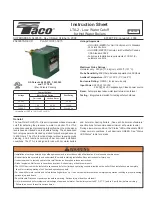
TFTN 085-199 Installation and Operation Manual
35
9.0
GAS VALVE AND BURNER SET-UP
Set-up of the TFTN gas valve must be performed by a licensed Gas Technician. Failure to perform
the set-up correctly may result in incorrect operation, component failure, property damage,
serious injury or death.
Combustion Calibration Procedure
To calibrate burner combustion, perform the following procedure using a calibrated combustion analyzer capable of
measuring CO
2
and CO from a Natural Gas or Propane burning appliance:
1.
Set analyzer
to the appropriate fuel (Natural Gas or Propane).
2.
Gas Line Pressure Test
–
monitor gas line pressure throughout all combustion tests and verify it is maintained within
tolerance. See
Gas Line Pressure Test
below.
3.
Set Throttle Screw
–
with the burner operating at Max Power (100%); set combustion according to Table 9-1 using the
Throttle Screw; allow time for the analyzer readings to stabilize between adjustments
–
record CO
2
value. See
Throttle
Screw Adjustment
section below.
4.
Set Offset Screw
–
with the burner operating at Min Power (10%); using the Offset Screw, set the CO
2
in accordance
with Table 9-1, i.e., 0.4-0.8% lower than the value obtained during the Max Power test for models TFTN285-399, and
0.2-1.0% lower than the value obtained during the Max Power test for models TFTN085-199. See
Offset Screw
Adjustment
section below.
Combustion Calibration is mandatory
upon installation and during each annual service. Failure
to perform the Combustion Calibration in accordance with these instructions may result in
incorrect combustion leading to burner damage or excessive Carbon Monoxide concentrations
causing property damage, personal injury, or death.
Carbon Monoxide
- Never leave the unit operating while producing Carbon Monoxide (CO)
concentrations more than 175 ppm. Failure to follow this warning may result in serious injury or
death.
Throttle Screw Adjustment
The gas valve Throttle Screw (see Figures 9-2 and 9-3) is used to calibrate the CO
2
concentration with the burner operating
at Max Power (100%).
TFTN285-399
–
turning the Throttle Screw in (clockwise) decreases the CO
2
concentration, while turning it out
(counterclockwise) increases the CO
2
concentration.
Typical adjustment required is 0
–
1
/
2
of a turn in or out from the
factory setting.
TFTN085-199
–
utilize a Throttle Screw with a left-hand thread; therefore, turning the Throttle Screw counterclockwise turns
it in, and decreases the CO
2
concentration (i.e., opposite to TFTN285-399 models). Turning the TFTN085-199 Throttle
Screw clockwise turns it out, and therefore increases the CO
2
concentration.
Typical adjustment required is 0
–
2 turns
in or out from the factory setting.
NOTE:
The modulation rate can be manually adjusted while in firing rate Test Mode
–
see Figure 9-1.
Adjustments to the
Throttle Screw
may only be made by a qualified gas technician using a
calibrated combustion analyzer capable of measuring CO
2
and CO. Adjustments may only be
performed if the gas line pressure is maintained above minimum levels throughout the duration
of the test (see Table 9-1). Failure to follow these instructions may result in serious injury or death.
Offset Screw Adjustment
The gas valve Offset Screw (see Figures 9-2 & 9-3) is used to calibrate the CO
2
offset at Min Power (10%) vs. Max Power
(100%). Turning the Offset Screw in (clockwise) increases the CO
2
concentration at Min Power (10%). Turning the Offset
Screw out (counterclockwise) decreases the CO
2
concentration at Min Power (10%).
Typical adjustment required is 0 -
1
/
4
of
a turn in or out from the factory setting.
NOTE:
Calibration of the Offset Screw must only be performed with the burner operating at Min Power (10%).
NOTE:
The modulation rate can be manually adjusted while in firing rate Test Mode
–
see Figure 9-1.
















































